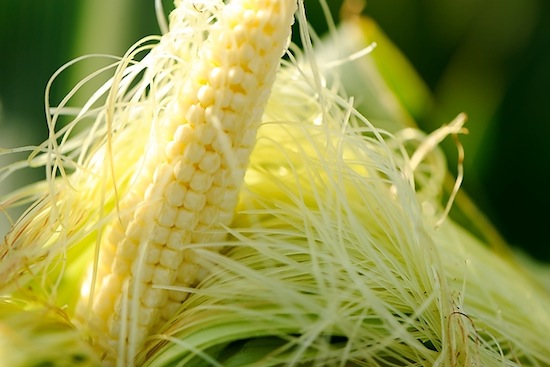Value of modified corn is more in reducing losses than boosting yields

A team of UW–Madison researchers has found that yields of genetically modified corn vary widely compared to conventional crops, but production risk is reduced — giving farmers more certainty about the yield levels they can expect.
Photo: Jeff Miller
While there’s no end of robust and heated conversation about genetically modified foods, there are strikingly few comprehensive studies that put a numeric value on the costs and benefits.
Now, there’s more to talk about.
By analyzing two decades worth of corn yield data from Wisconsin, a team of UW–Madison researchers has quantified the impact that various popular transgenes have on grain yield and production risk compared to conventional corn. Their analysis, published online in a Nature Biotechnology correspondence article on Feb. 7, confirms the general understanding that the major benefit of genetically modified (GM) corn doesn’t come from increasing yields in average or good years, but from reducing losses during bad ones.

Lauer
“For the first time we have an estimate of what genetically modified hybrids mean as far as value for the farmer,” says UW–Madison and UW-Extension corn agronomist Joe Lauer, who led the study.
Lauer, who is also a UW-Extension corn agronomist, has been gathering corn yield and other data for the past 20 years as part of the Wisconsin Corn Hybrid Performance Trials, a project he directs. Each year, his team tests about 500 different hybrid corn varieties at more than a dozen sites around the state with the goal of providing unbiased performance comparisons of hybrid seed corn for the state’s farmers. When GM hybrids became available in 1996, Lauer started including them in the trials.
“It’s a long-term data set that documents one of the most dramatic revolutions in agriculture: the introduction of transgenic crops,” says Lauer, who collaborated with UW–Madison agricultural economists Guanming Shi and Jean-Paul Chavas to conduct the statistical analysis, which considered grain yield and production risk separately.
Grain yield varied quite a bit among GM hybrids. While most transgenes boosted yields, a few significantly reduced production. At the positive end of the spectrum was the Bt for European Corn Borer (ECB) trait. Corn plants with this added transgene, which comes from the bacterium Bacillus thuringiensis, are protected from a damaging caterpillar. When the researchers combined the yield data from all of the ECB hybrids grown in the trials over the years, they found that the ECB plants out-yielded conventional hybrids by an average of more than six bushels per acre per year. GM hybrids with “stacked traits,” or multiple transgenes, tended to have slightly improved yields — an extra two or three bushels per acre. On the other hand, grain yields from hybrids with the Bt for Corn Rootworm (CRW) transgene trailed those of regular hybrids by a whopping 12 bushels per acre.
“A lot of farmers assume that if it’s transgenic, it’s great in terms of yield, but we know that putting a transgene into a corn hybrid isn’t always successful. You don’t want to pay $75 dollars more per bag of seed to produce 12 bushels less per acre.”
Joe Lauer
“A lot of farmers assume that if it’s transgenic, it’s great in terms of yield, but we know that putting a transgene into a corn hybrid isn’t always successful,” says Lauer. “You don’t want to pay $75 dollars more per bag of seed to produce 12 bushels less per acre.”
However, even among poor-performing groups of GM corn, there are individual varieties that perform quite well, Lauer notes. “It depends on how the transgene interacts with the underlying germplasm,” he says. “My message to farmers is that every hybrid has to stand on its own.”
Where transgenic corn clearly excels is in reducing production risk. The researchers found that every GM trait package — whether single gene or stacked genes — helped lower variability. For farmers, lower variability means lower risk, as it gives them more certainty about the yield levels they can expect.
This makes sense, explains Lauer. “The traits themselves don’t add to yield. What they do is protect the yield, so any kind of yield advantage we can get from [a variety of hybrid corn] will be protected from pests,” he says.
Lauer equates choosing GM to purchasing solid-performing, low-risk stocks. Just as safe stocks have relatively low volatility, yields from GM crops don’t swing as wildly from year to year, and most important, their downswings aren’t as deep.
GM crops help reduce downside risk by reducing losses in the event of disease, pests or drought. Economists Shi and Chavas estimated the risk reduction provided by modified corn to be equivalent to a yield increase ranging from 0.8 to 4.2 bushels per acre, depending on the variety.
Risk reduction associated with GM corn can add up to significant savings for farmers — as much as $50,000 for 1,000 acres, calculates Lauer. “It depends on the price that farmers can receive for corn,” he says.
The two factors quantified in this study, yield and production risk, are just a part of the overall picture about GM crops, says Lauer. He notes there are other quantifiable values, such as reduced pesticide use, as well as ongoing concerns about the safety and health of growing and eating genetically modified foods.
“There’s a lot of concern about this biotechnology and how it’s going to work down the road,” says Lauer, “and yet farmers have embraced it and adopted it here in the U.S. because it reduces risk and the yield increases have been as good as, or some would argue a little better than, what we’ve seen with regular hybrid corn.”
Tags: agriculture, biosciences



